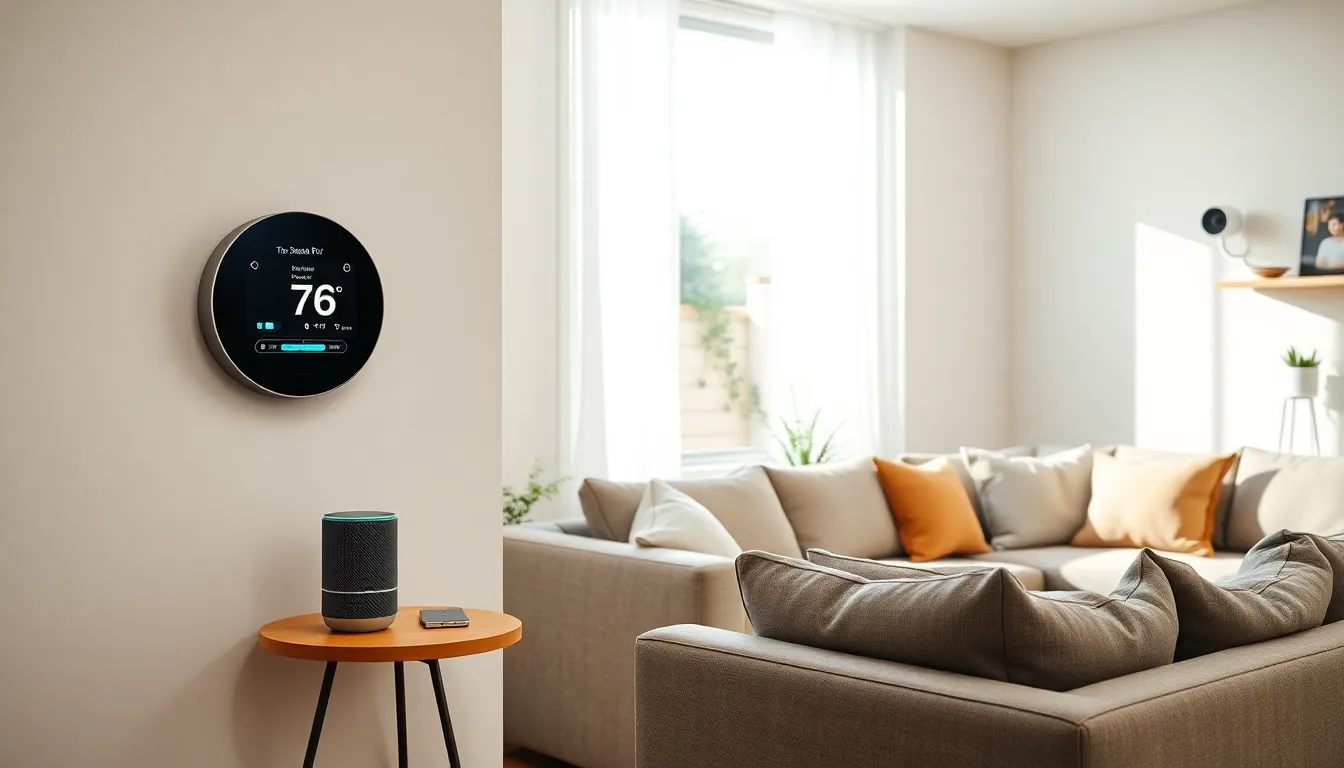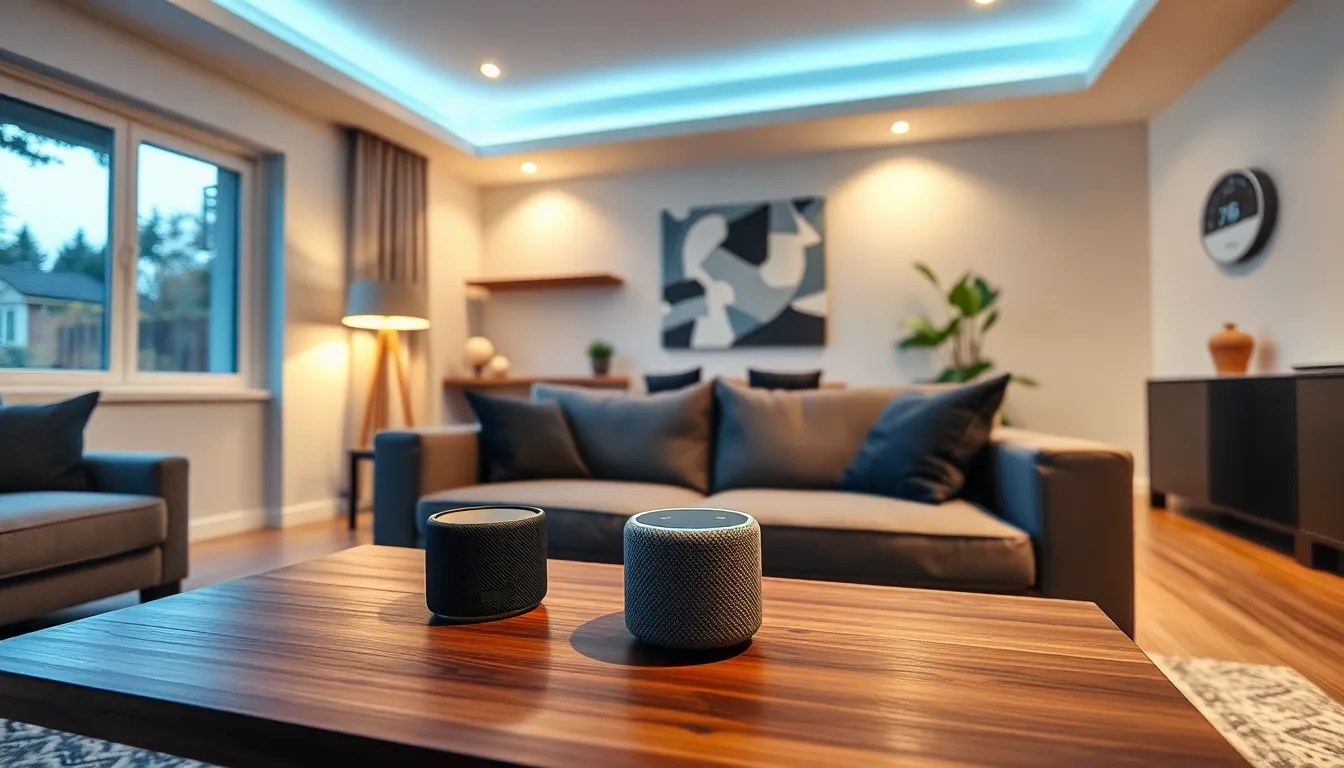Imagine a world where your coffee brews itself while you’re still dreaming about that extra hour of sleep. Smart home technology isn’t just a futuristic fantasy; it’s a reality that’s making life easier, one gadget at a time. From voice-activated assistants to smart thermostats that know your comfort preferences better than your best friend, these innovations are here to revolutionize daily living.
But don’t worry—your home won’t start talking back (yet). Instead, it’ll help you save time, energy, and maybe even a little sanity. Whether you’re a tech enthusiast or someone who struggles to turn on the TV, smart home technology offers solutions that fit every lifestyle. So buckle up and get ready to explore how these clever devices can transform your home into a haven of convenience and efficiency.
Table of Contents
ToggleOverview Of Smart Home Technology
Smart home technology encompasses a range of devices that connect to the internet, enhancing convenience and efficiency. These devices include smart thermostats, security cameras, lighting systems, and voice-activated assistants. Users gain control over their environments remotely, promoting comfort and security.
Smart thermostats intelligently learn schedules, optimizing energy usage and minimizing costs. They adjust temperatures based on occupancy patterns. Security cameras provide real-time alerts, helping homeowners monitor their properties from anywhere.
Lighting systems can be programmed or controlled via apps, allowing homeowners to set moods or schedules. Voice-activated assistants streamline daily tasks, enabling users to manage devices with simple voice commands.
Integration is a key feature of smart home technology. Smart hubs connect various devices, facilitating seamless communication between them. This connectivity offers users an all-in-one solution for managing their smart home environments.
Adoption rates for smart home technology have risen significantly, with research indicating that approximately 30% of U.S. households use at least one smart device. The demand continues to grow, driven by advancements in artificial intelligence and the Internet of Things (IoT).
Incorporating smart technology into homes not only enhances efficiency but also contributes to increased safety and sustainability. As consumers increasingly prioritize energy conservation, smart devices emerge as essential tools for modern living. This evolution in home management transforms everyday routines, making them easier and more enjoyable.
Benefits Of Smart Home Technology
Smart home technology offers various advantages that enhance daily living experiences.
Convenience And Comfort
Smart devices streamline tasks, making daily routines easier. Voice-activated assistants allow users to control appliances with simple commands. Automated lighting adjusts based on user preferences, providing the right ambiance without manual effort. Smart thermostats learn individual schedules to maintain comfortable temperatures efficiently. Integration among devices contributes to a cohesive ecosystem, making management intuitive. These features cater to everyone, from tech enthusiasts to those seeking simplicity in everyday life.
Energy Efficiency
Energy savings represent a significant advantage of smart home technology. Smart thermostats optimize energy usage by adjusting temperatures based on occupancy. Devices can be programmed to turn off when not in use, reducing energy waste. Homeowners can monitor energy consumption through applications, promoting informed usage decisions. Innovations in devices also promote sustainable living by minimizing carbon footprints. The collective impact of these solutions leads to lower utility bills and a more eco-friendly lifestyle.
Enhanced Security
Security systems provide robust protection for homes through technology. Smart cameras offer real-time monitoring alerts sent directly to smartphones. Motion sensors detect unusual activity, enhancing situational awareness. Smart locks allow keyless entry, enabling secure access for authorized individuals only. Integration with home automation systems minimizes vulnerabilities while ensuring safety. Overall, these features create a safer environment, giving homeowners peace of mind.
Popular Smart Home Devices
Smart home devices enhance comfort and convenience while promoting energy efficiency. With various options available, individuals can customize their smart home experience to fit their needs.
Smart Speakers
Smart speakers serve as central hubs for controlling other devices. These devices respond to voice commands, allowing users to play music, set reminders, or even adjust smart lights. Examples include Amazon Echo and Google Nest, both equipped with voice assistants. Integration with other smart home systems enhances functionality, providing seamless management of tasks. Approximately 20% of U.S. households have adopted smart speakers, reflecting growing interest in these versatile gadgets.
Smart Thermostats
Smart thermostats optimize home heating and cooling efficiently. By learning user schedules, these devices adjust temperatures automatically to save energy. Popular models like Nest and Ecobee provide users with insights into energy usage patterns. Remote control accessibility via smartphone apps allows for easy adjustments while away. Studies show that utilizing smart thermostats can reduce energy bills by up to 15%, providing financial benefits alongside increased comfort.
Smart Security Cameras
Smart security cameras enhance home safety through real-time monitoring. These devices capture video footage and send alerts directly to users’ smartphones. Options like Ring and Arlo offer features such as two-way audio and night vision for comprehensive security. Many systems allow for cloud storage of footage, ensuring important events remain accessible. Statistics indicate that about 25% of U.S. households utilize smart security cameras, demonstrating a commitment to safety and security.
Challenges And Considerations
Smart home technology presents several challenges that users must navigate. Addressing concerns related to privacy and compatibility ensures a smooth experience with smart devices.
Privacy Concerns
Privacy plays a crucial role when adopting smart home technology. Many smart devices collect personal data, which poses potential risks if not adequately secured. Users often face situations where connected devices like cameras and voice assistants may inadvertently record conversations or activities. The risk of hacking remains a significant concern, as unauthorized access can lead to data breaches. Additionally, companies often require consent to gather user data, leading to transparency issues. Awareness of how devices store and share information helps homeowners protect their privacy while enjoying the benefits of smart technology.
Compatibility Issues
Compatibility among different smart devices presents another challenge for users. Not all devices seamlessly integrate with one another, leading to frustration during setup. Each manufacturer often designs products that work best within its ecosystem, limiting options for consumers. Users regularly encounter situations where smart hubs might only support specific brands or protocols, complicating the experience. Considering this lack of standardization in the market, careful research on compatibility is essential before purchasing smart home devices. Ensuring devices communicate effectively is vital for maximizing the benefits of a smart home setup.
Future Trends In Smart Home Technology
Emerging trends in smart home technology reflect advancements in artificial intelligence and the Internet of Things (IoT). Innovations will likely focus on deeper integration of devices, enabling them to communicate more effectively.
Increased personalization will enhance user experiences, allowing devices to adapt preferences and routines. For instance, smart thermostats might not only learn schedules but also adapt automatically to external conditions for optimal energy efficiency.
Voice control is set to evolve further, making interactions even more intuitive and seamless. Smart speakers will incorporate advanced natural language processing, improving responsiveness to spoken commands.
Sustainability trends will play a significant role in future developments. Smart devices with energy management capabilities will become more prevalent, helping households monitor and reduce energy consumption.
Security features are expected to advance as well. New solutions may integrate biometrics and AI-driven surveillance systems, enhancing protection against threats and intrusions.
Interoperability standards are likely to improve, leading to enhanced compatibility among different brands and devices. As a result, users can expect a more cohesive ecosystem, streamlining management and control.
Finally, as adoption rates increase—currently 30% of U.S. households utilize at least one smart device—education around smart technology will gain importance. More resources will inform consumers about secure usage and device management, ensuring the benefits of smart homes are maximized.
Conclusion
Smart home technology is reshaping the way people interact with their living spaces. By leveraging innovative devices and seamless integration, homeowners can enjoy greater convenience and improved energy efficiency. As adoption continues to rise, understanding the benefits and challenges of these technologies becomes essential.
Future advancements promise even more intuitive interactions and enhanced security features, paving the way for a more connected lifestyle. Staying informed about these trends will empower individuals to make the most of their smart home investments. Embracing this technology not only streamlines daily tasks but also fosters a more sustainable and secure home environment.



